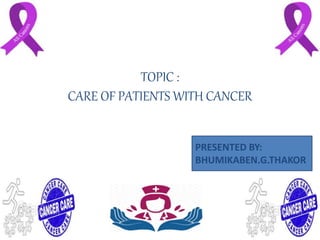
CARE OF PATIENTS WITH CANCER BY BHUMIKA.G.THAKOR
- 1. TOPIC : CARE OF PATIENTS WITH CANCER PRESENTED BY: BHUMIKABEN.G.THAKOR
- 2. INTRODUCTION Nurses have traditionally been involved with the care, tertiary prevention and rehabilitation of patients after cancer diagnosis and treatment.
- 3. HOLISTIC NURSING CONSIDERATIONS 1) Primary level care: Prevention and Screening/ client education 2) Secondary level care: Diagnostic Testing Treatment and side-effects of Surgery, Radiotherapy ,Chemotherapy 3) Tertiary level care: End of life and psychosocial issues
- 4. 1) Primary level care: PREVENTION AND SCREENING Patient Education Health promotion: Diet high in whole grains,Vit C, & fruits & vegetables. Limit fat, alcohol, smoked. Maintain healthy immune system. Avoidance of carcinogens: Limit exposure to sun, tobacco smoke/chew, radiation, viruses,chronic irritants, immunosuppressants.
- 5. Continue… Regular cancer screening : ACS Cancer Detection Guidelines C A U T I O N Annual physical exam,
- 6. Continue… BREAST SELF EXAMINATION TESTICULAR SELF EXAMINATION
- 7. 2) SECONDARY level care: DIAGNOSTIC TESTING Patient Education And Support Common laboratory tests: CBC, bilirubin, alkaline and acid phosphatase, tumor markers (PSA) Radiological procedures: CT, PET, MRI, ultrasound, mammography Endoscopic procedures: Bronchoscopy, Esophagoscopy etc.
- 8. CANCER TREATMENT CHEMOTHERAPY Nursing Care Prior to administration: hydration and anti-emetics During administration: vesicant precautions: gloves, monitor IV site closely Post administration: utilize interventions for common side effects: Myelo suppression infection, bleeding, fatigue , GI complications – anorexia,Nausea/Vomiting, xerostomia, Alopecia
- 9. Chemotherapeutic Agents/ Anti Neo plastic Drugs Examples : Alkylating Agents e.g Cytoxan, Cisplatin Antimetabolites e.g Methotrexate ,5-FU Plant Alkaloids (Anti-mitotics) e.g Vincristine (Oncovin) Antibiotics e.g Bleomycin
- 10. Immunotherapy/Targeted Therapy Biological Response Modifiers(BRM) Interferon Monoclonal Antibodies – Herceptin Interleukin Colony Stimulating Factor (CSF)- Neupogen ,Epogen Gene Therapy
- 11. CANCER TREATMENT EXTERNAL RADIATION Nursing Care Teletherapy : • Promote nutrition and rest • Do not remove simulation markings • Utilize interventions for common side effects: Myelosuppression – infection, bleeding, fatigue GI complications – anorexia, Nausea/Vomiting, taste alterations, mucositis, xerostomia, diarrhea
- 12. CANCER TREATMENT INTERNAL RADIATION Nursing Care Brachytherapy – Sealed vs Unsealed Safety considerations: • Private room. Radioactive caution sign • Limit visitors to ½ hr; no under 18, • no pregnant • Rotate nurse assignments/ wear dosimeter
- 13. CANCER TREATMENT – SURGERY NursingCare Pre-operative teaching Nutritional promotion pre and post operative Pain control Monitor for post-operative complications
- 14. THE PATIENT WITH CANCER A NURSING PROCESS APPROACH The following common problems should be considered: Infection Bleeding Pain Malnutrition Fatigue Psychosocial Issues
- 15. FOCUSEDASSESSMENT of the Patient with Cancer S/S of bleeding: Platelets, CBC, gums, stools, urine, skin, LOC S/S of infection: Temp, WBC, respiratory, urinary, skin, invasive sites Pain: W H A T S U P or S L I D A Nutritional Status: Weight, serum albumin & transferrin, appetite, Nausea &Vomiting, diarrhea, food aversions/preferences Coping skills of patient and Patient knowledge: disease, treatment, outcomes
- 16. DIAGNOSIS Chronic pain r/t disease process and therapy Nutrition, imbalanced; less than body requirements r/t anorexia, Fatigue r/t myelosuppression Risk for injury r/t bleeding tendencies Risk for infection r/t diminished immunity Risk for ineffective coping r/t diagnosis of cancer Body image disturbance r/t surgical Intervention / alopecia
- 17. PLANNING Patient will demonstrate: Platelet, CBC, albumin, transferrin levels in normal range No evidence of bleeding No evidence of infection Pain relieved and/or controlled Progressive weight gain toward goal Performance of ADLs within level of ability Verbalized awareness of own coping abilities
- 18. IMPLEMENTATION CHRONIC PAIN R/T DISEASE PROCESS Acknowledge and accept patient report Determine patient’s acceptable pain level Administer analgesics per MD orders Utilize cognitive-behavioral strategies: • Guided imagery • Distraction • Relaxation etc.
- 19. NUTRITION IMBALANCED; LESS THAN BODY REQUIREMENTS R/T ANOREXIA Monitor serum albumin, transferrin, body weight, intake & output Identify patient food likes and dislikes Offer small frequent nutrient dense meals/snacks Administer anti-emetics & analgesics ac per MD orders ANTI-EMETIC Examples:Zofran, TIgan, Ativan, Compazine
- 20. RISK FOR INFECTION R/T DIMINISHED IMMUNITY Monitor WBC Daily Observe closely for S/S infection Neutropenic precautions: limit invasive procedures, private room, no exposure to communicable illness strict hand washing, no fresh flower, fruits, vegetables,
- 21. RISK FOR INJURY R/T BLEEDING TENDENCIES Monitor platelet, CBC, H&H levels Observe for S/S bleeding and or hypoxia Bleeding precautions: gentle handling, fall precautions, electric razor, soft toothbrush, gentle nose blowing, avoid invasive procedures, no rectal temps, no intercourse Administer stool softeners as per MD orders Administer transfusion therapy as per MD orders
- 22. RISK FOR INEFFECTIVE COPING BODY IMAGE DISTURBANCE Utilize effective communication techniques and attentive listening skills Encourage patient verbalizations of fears and concerns Provide information on support groups, hospice care • Provide information regarding plastic surgery, prosthetic options
- 23. EVALUATION PATIENT WILL: Be free from bleeding, infecti Verbalize relief, reduction and control of pain Maintain optimal nutritional status free of Nausea &V Perform ADLs to desired level Express feelings about disease, prognosis, body image, etc. Demonstrate healthy coping mechanisms
- 24. SUPPORTIVE CARE OF PATIENTWITH CANCER Symptom control caring for them in their own home if they so wish Supporting them if they decide to refuse treatment for their cancer Emotional support Psychosocial support
- 25. ADDITIONAL CONSIDERATIONS Palliative care Hospice care Complementary therapies Community-based care Evidence-based practice Clinical trials and research